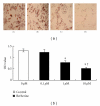Berberine improves insulin sensitivity by inhibiting fat store and adjusting adipokines profile in human preadipocytes and metabolic syndrome patients
- PMID: 22474499
- PMCID: PMC3310165
- DOI: 10.1155/2012/363845
Berberine improves insulin sensitivity by inhibiting fat store and adjusting adipokines profile in human preadipocytes and metabolic syndrome patients
Abstract
Berberine is known to inhibit the differentiation of 3T3-L1 cells in vitro, improve glycemic control, and attenuate dyslipidemia in clinical study. The aim of this study was to investigate the effects of berberine on preadipocytes isolated from human omental fat and in metabolic syndrome patients treated with berberine for 3 months. We have shown that treatment with 10 μM berberine resulted in a major inhibition of human preadipocyte differentiation and leptin and adiponectin secretion accompanied by downregulation of PPARγ2, C/EBPα, adiponectin, and leptin mRNA expression. After 3 months of treatment, metabolic syndrome patients showed decrease in their BMI (31.5 ± 3.6 versus 27.4 ± 2.4 kg/m(2)) and leptin levels (8.01 versus 5.12 μg/L), as well as leptin/adiponectin ratio and HOMA-IR. These results suggest that berberine improves insulin sensitivity by inhibiting fat store and adjusting adipokine profile in human preadipocytes and metabolic syndrome patients.
Figures





Similar articles
-
GW4064, a farnesoid X receptor agonist, upregulates adipokine expression in preadipocytes and HepG2 cells.World J Gastroenterol. 2014 Nov 14;20(42):15727-35. doi: 10.3748/wjg.v20.i42.15727. World J Gastroenterol. 2014. PMID: 25400456 Free PMC article.
-
Low number of omental preadipocytes with high leptin and low adiponectin secretion is associated with high fasting plasma glucose levels in obese subjects.Diabetes Obes Metab. 2006 Sep;8(5):585-8. doi: 10.1111/j.1463-1326.2006.00558.x. Diabetes Obes Metab. 2006. PMID: 16918595
-
Relationship of adipokine to insulin sensitivity and glycemic regulation in obese women--the effect of body weight reduction by caloric restriction.Vojnosanit Pregl. 2013 Mar;70(3):284-91. doi: 10.2298/vsp1303284v. Vojnosanit Pregl. 2013. PMID: 23607240
-
[Effect of berberine on the differentiation of adipocyte].Zhonghua Yi Xue Za Zhi. 2003 Feb 25;83(4):338-40. Zhonghua Yi Xue Za Zhi. 2003. PMID: 12812656 Chinese.
-
Nuciferine Inhibited the Differentiation and Lipid Accumulation of 3T3-L1 Preadipocytes by Regulating the Expression of Lipogenic Genes and Adipokines.Front Pharmacol. 2021 Mar 22;12:632236. doi: 10.3389/fphar.2021.632236. eCollection 2021. Front Pharmacol. 2021. PMID: 33841152 Free PMC article.
Cited by
-
Berberine improves advanced glycation end products‑induced osteogenic differentiation responses in human periodontal ligament stem cells through the canonical Wnt/β‑catenin pathway.Mol Med Rep. 2019 Jun;19(6):5440-5452. doi: 10.3892/mmr.2019.10193. Epub 2019 Apr 25. Mol Med Rep. 2019. PMID: 31059099 Free PMC article.
-
Liposome-Encapsulated Berberine Alleviates Liver Injury in Type 2 Diabetes via Promoting AMPK/mTOR-Mediated Autophagy and Reducing ER Stress: Morphometric and Immunohistochemical Scoring.Antioxidants (Basel). 2023 Jun 5;12(6):1220. doi: 10.3390/antiox12061220. Antioxidants (Basel). 2023. PMID: 37371950 Free PMC article.
-
Association between Single Nucleotide Polymorphism rs9891119 of STAT3 Gene and the Genetic Susceptibility to Type 2 Diabetes in Chinese Han Population from Guangdong.J Healthc Eng. 2021 Mar 24;2021:6657324. doi: 10.1155/2021/6657324. eCollection 2021. J Healthc Eng. 2021. PMID: 33833859 Free PMC article.
-
A Composition of Phytonutrients for Glycemic and Weight Management.Nutrients. 2022 Sep 14;14(18):3784. doi: 10.3390/nu14183784. Nutrients. 2022. PMID: 36145160 Free PMC article.
-
The role of serum inflammatory cytokines and berberine in the insulin signaling pathway among women with polycystic ovary syndrome.PLoS One. 2020 Aug 12;15(8):e0235404. doi: 10.1371/journal.pone.0235404. eCollection 2020. PLoS One. 2020. PMID: 32785222 Free PMC article.
References
-
- Eckel RH, Grundy SM, Zimmet PZ. The metabolic syndrome. The Lancet. 2005;365(9468):1415–1428. - PubMed
-
- C. Huang K, M. Williams W. Antibacterial, antiviral, and antifungal herbs. Pharmacology of Chinese Herbs. 1999;8(6):381–383.
-
- Amin AH, Subbaiah TV, Abbasi KM. Berberine sulfate: antimicrobial activity, bioassay, and mode of action. Canadian Journal of Microbiology. 1969;15(9):1067–1076. - PubMed
-
- Anis KV, Rajeshkumar NV, Kuttan R. Inhibition of chemical carcinogenesis by berberine in rats and mice. Journal of Pharmacy and Pharmacology. 2001;53(5):763–768. - PubMed
-
- Kuo CL, Chi CW, Liu TY. The anti-inflammatory potential of berberine in vitro and in vivo. Cancer Letters. 2004;203(2):127–137. - PubMed
LinkOut - more resources
Full Text Sources
Other Literature Sources

